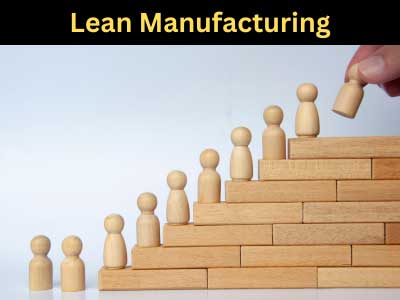Key Takeaway
Kaizen is a Japanese term meaning “good change” or continuous improvement. In lean manufacturing, Kaizen focuses on making small, incremental changes in processes to reduce waste, boost productivity, and enhance efficiency. It encourages everyone in the organization, from workers to management, to contribute ideas for improvement. The cumulative effect of these small changes leads to significant long-term improvements. Kaizen also fosters a culture of teamwork and proactive problem-solving. By adopting Kaizen, companies can achieve sustained, long-term growth, improving both efficiency and overall operational success.
The Philosophy of Kaizen in Lean
At the heart of Kaizen is the belief that continuous improvement is essential for long-term success. Rather than waiting for big, disruptive changes, the Kaizen philosophy encourages making small adjustments on a regular basis. This mindset fosters a culture where every employee is engaged in identifying inefficiencies and suggesting ways to improve the process.
In Lean manufacturing, Kaizen isn’t just about increasing efficiency—it’s about building a work environment that values employee input and collaborative problem-solving. By embracing the Kaizen philosophy, organizations can create a culture of innovation where every team member is empowered to contribute to improvement efforts. For new engineers, adopting the Kaizen mindset means understanding that even minor adjustments can have a big impact on overall performance.

How Kaizen Drives Continuous Improvement
Kaizen is the engine that drives continuous improvement in Lean manufacturing. The process typically follows a cycle known as PDCA (Plan, Do, Check, Act). This cycle involves planning a change, implementing it on a small scale, checking the results, and then standardizing the improvement if it proves successful.
The beauty of Kaizen is that it encourages quick, small-scale improvements that can be tested and refined without interrupting production. These small changes may include reducing the time it takes to perform a specific task, reorganizing a workstation for better workflow, or adjusting production schedules to reduce downtime.
For new engineers, learning how Kaizen drives continuous improvement means understanding that no process is ever perfect. There are always ways to enhance efficiency, reduce waste, or improve quality. By constantly seeking out small improvements, teams can make a big difference in the long run.
Implementing Kaizen in Daily Manufacturing Practices
One of the reasons Kaizen is so effective is that it’s deeply integrated into daily manufacturing practices. Kaizen isn’t a separate initiative; it’s something that happens every day, at every level of the organization. It starts with workers on the production floor identifying small inefficiencies or problems they encounter in their day-to-day work. These issues are then discussed in team meetings, and solutions are proposed and tested.
An important aspect of Kaizen is that it encourages action. Once a problem or inefficiency is identified, teams are encouraged to implement a solution quickly rather than waiting for extensive analysis or approvals. This approach helps keep the momentum of improvement going and fosters a proactive mindset in workers.
For new engineers, implementing Kaizen means being actively involved in the day-to-day process of identifying and solving problems. By focusing on continuous, incremental changes, they can contribute to building a more efficient and agile manufacturing operation.
Employee Involvement in the Kaizen Process
Employee involvement is a critical component of the Kaizen process. Since the people closest to the production process often have the best insights into inefficiencies, Kaizen encourages employees at all levels to take part in improvement efforts. Workers are empowered to take ownership of their tasks and propose changes that can make their work more efficient or reduce waste.
This involvement creates a sense of responsibility and engagement, where employees feel valued for their contributions. Regular Kaizen events or workshops, often called Kaizen Blitzes, are held to focus on specific areas of improvement over short periods, with employees playing a key role in brainstorming solutions.
For new engineers, understanding the importance of employee involvement is essential. Kaizen is most effective when it’s a team effort. By working closely with frontline workers, engineers can help implement solutions that are practical, efficient, and grounded in real-world experience.
Measuring the Impact of Kaizen on Productivity
In any Lean system, it’s important to measure the impact of Kaizen efforts to ensure that changes are producing the desired results. Metrics such as productivity levels, cycle times, defect rates, and downtime are often used to evaluate the effectiveness of Kaizen initiatives. By collecting and analyzing data, teams can determine whether the changes they’ve implemented are making a meaningful difference.
Kaizen also emphasizes the importance of reflecting on these results and using them to inform future improvement efforts. If an implemented change doesn’t deliver the expected results, teams are encouraged to reassess the situation and try a new approach. This iterative process ensures that improvement is continuous and data-driven.
For new engineers, learning to measure the impact of Kaizen is critical. It involves not just implementing changes but also assessing their effectiveness and refining them based on real-world data. This analytical approach helps ensure that improvements are sustainable and lead to long-term gains in productivity.
Conclusion
Kaizen is a powerful tool for driving continuous improvement in Lean manufacturing. By focusing on small, incremental changes and fostering a culture of employee involvement, Kaizen helps organizations improve efficiency, reduce waste, and boost productivity. For new engineers, mastering the principles of Kaizen is essential for contributing to a Lean manufacturing environment.
By understanding the Kaizen philosophy, implementing it in daily practices, involving employees, and measuring its impact, engineers can help drive meaningful, lasting improvements in operations. The power of Kaizen lies in its simplicity—small, steady improvements add up to significant operational gains over time.
